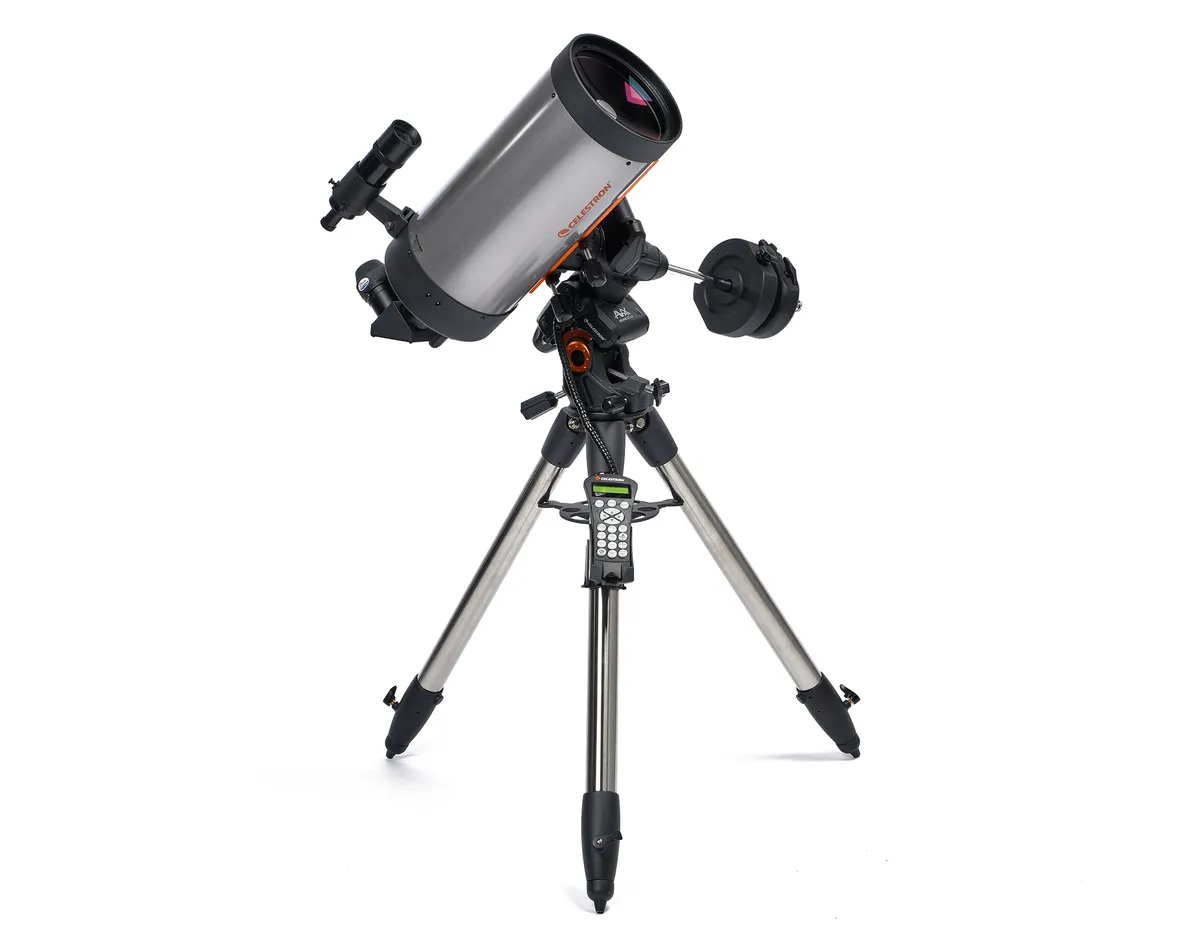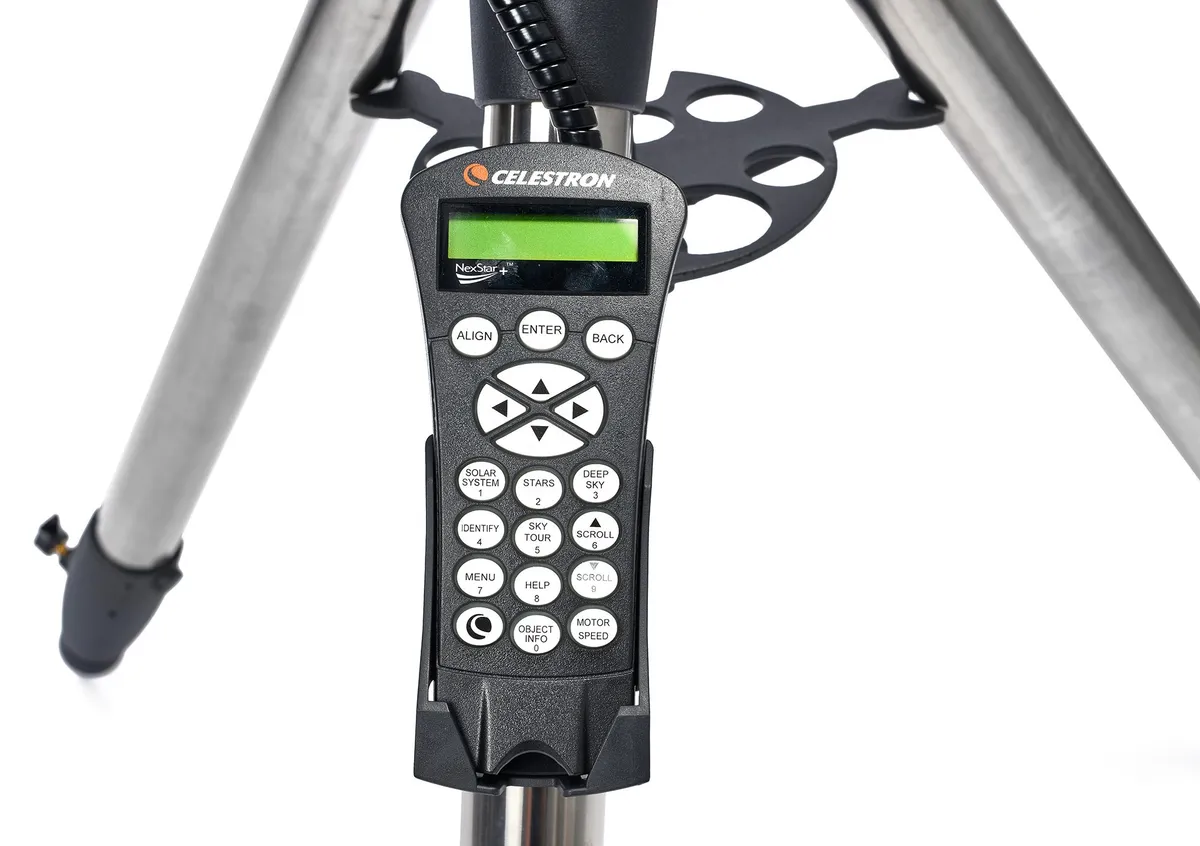As we begin this review of the Celestron Advanced VX 700 Maksutov-Cassegrain, here’s a quick refresher on some terminology. The term ‘catadioptric’ describes using lenses and mirrors to shape incoming light in a telescope.
The popular Schmidt-Cassegrain telescope (SCT) is a catadioptric, as is the Celestron model we’re reviewing here.
‘Cassegrain’ refers to the combination of a concave primary mirror and a convex secondary, while ‘Maksutov’ refers to the shape of the instrument’s front corrector plate.
Both Schmidt-Cassegrain and Maksutov-Cassegrain telescopes use primary mirrors, which are sections of a sphere. Such mirrors suffer from spherical aberration, producing poor off-axis focus (coma).
This is countered in SCTs by using flat corrector plates with a slight aspheric curve; ‘aspheric’ means the curvature is not a portion of a sphere.
Maksutov-Cassegrains make use of highly curved correctors which are part of a sphere. These are thicker than their SCT equivalents and typically require greater cool-down times.
The Maksutov-Cassegrain design also produces a longer natural focal length compared to a similar-sized SCT.
Celestron’s VX 700 Maksutov-Cassegrain is an f/15 instrument with a focal length of 2,700mm. This makes it ideal for getting close views of the planets and the Moon, but it’s not so great for large deep-sky objects.
During testing we took a tour around the Moon’s surface using the supplied 28mm eyepiece.
The views were excellent; there was lots of detail and the contrast between the bright highlands, dark lava seas and deep black shadows was impressive.
The shadows cast by the lunar Alps were dramatic and reminiscent of being cast by a giant cathedral.
Under poor seeing and using the supplied medium power eyepiece, lots of fine detail was discernible, including both craters within 57km Cassini – 17km Cassini A and 9km Cassini B.
Although the long natural focal length isn’t optimal for large deep-sky objects, the telescope performsvery well on smaller ones.
We could discern some of the nebulosity within the Running Man Nebula, NGC 1977, and the Crab Nebula’s squashed, irregular shape was seen easily using direct vision.

One thing to bear in mind if you’re into astrophotography is that f/15 is quite slow, meaning you’ll need longer exposures to match the exposure depth of faster instruments.
Other test views of the Ring Nebula, M57, were fantastic. Its glow was evident, and you could make out the dark inner portion with direct vision.
As Albireo was up in the night sky we conducted a colour test and there were no problems. The warm gold-yellow of the primary contrasted well with the blue-hued secondary.
Meanwhile, the Orion Nebula, M42, showed a wealth of detail with contrast being held across the unevenly illuminated gas of the nebula.
An 8x50 findersccope is supplied and it’s essential to get this fitted and aligned as soon as possible.
The optical tube is supplied with a CGE (Losmandy-compatible) dovetail bar and this was easy to attach to the VX mount head.
Our only, slightly picky, gripe with the optical tube was the annoying plastic dust cover which fell off far too easily.When it does stay on, the cover is slightly convex meaning you can’t stand the tube on its end.
We found the focuser to be adequate, but image shift does occur when winding in different directions. This is evident at large image scales.
The scope is part of the package, including a tripod and a Celestron VX mount head. This is a well-constructed piece of kit, and it’s well-suited to a 7-inch Maksutov-Cassegrain.
The mount head isn’t overly heavy and the whole setup is portable and easy to assemble on your own.
Overall, our experience with the Celestron Advanced VX 700 Maksutov-Cassegrain was good and we can heartily recommend it.
However, just be aware that a 2.7 metre (2,700mm) focal length can require careful management. Fit a 2x Barlow and your effective focal length is 5.4 metres!
If you’re looking for wide vistas of the heavens, this is not the scope for you. But if you want to get up close and personal to your targets, this instrument will help you do this confidently.
Easy handling
The Maksutov-Cassegrain design produces a powerful, long focal length instrument in an easy to handle package. Lifting the scope on and off the VX mount was easy.
The thicker meniscus Maksutov corrector means you need to leave a bit more cool-down time, but for this 7-inch instrument we found this didn’t need to be more than 60–90 minutes.
We loved the long focal length: it’s something that becomes addictive. Being a slow instrument, it’s best suited for brighter objects, but even with a fairly modest eyepiece you get a fairly close-up view of your target.
For the planets or the Moon, this is an excellent portable telescope.
The secondary mirror is a silvered portion of the inside surface of the corrector plate. For this 7-inch scope the silvered circle measures 42mm, which is 23.3 per cent by diameter of the corrector (5.43 per cent by area).
Views through the eyepiece revealed excellent contrast, with black shadows inside lunar craters being a memorable sight during testing. The corrector has StarBright XLT optical coating, which helps contrast.

8x50 finderscope
A long focal length instrument such as this requires a good finderscope. Celestron provide an 8x50 straight through finderscope which may be connected to the main optical tube assembly via a small shoe and clamp arrangement. We found this finder worked well, but an illuminated cross-hair upgrade would have been even better.
Tripod
The scope and mount head sit on a sturdy tripod. Each leg has a diameter of 50.8mm and the tripod assembly permits height adjustment between 1,118mm and 1,626mm. We found the combination of the supplied tripod, VX mount and optical tube assembly worked very well, offering good stability even at large image scales.
NexStar+ Go-To computer
The VX mount is controlled via Celestron’s NexStar+ hand controller. We were very impressed with the Go-To accuracy of this mount. After a two-star align with two further calibrations, our test targets centred every time. The available alignment options are two-star, one-star, Solar System, last- and quick align. The on-board database offers over 40,000 Go-To targets.
Advanced VX mount head
The Celestron Advanced VX mount is a sturdy equatorial telescope platform. Adjustable for 7–77˚ latitudes, it comes with both a declination (dec.) and right ascension (RA) drive. It supports three auxiliary ports, one of which is used by the NexStar+ handset. The design uses DC servo motors and offers permanently programmable periodic error correction. It’s not the quietest mount when slewing.
Focuser and visual back
Focusing is achieved using a rotating knob on the back of the optical tube. High precision focusing is marred slightly by image-shift which occurs when the focus knob is rotated in different directions. The visual back supports 2-inch equipment, or 1.25-inch barrels via a supplied 2-inch to 1.25-inch adaptor.
Vital stats
- Price £2,395
- Optics Maksutov-Cassegrain
- Aperture 180mm (7-inch)
- Focal length 2,700mm (f/15)
- Mount Advanced VX German equatorial
- Weight 8.6kg (optical tube assembly), 7.7kg (VX mount head), 8.2kg (tripod)
- Counterweights 2 x 5.4kg
- Supplier David Hinds Ltd
- Tel +44 (0)1525 852696
- www.dhinds.co.uk
This review originally appeared in the March 2020 issue of BBC Sky at Night Magazine.
